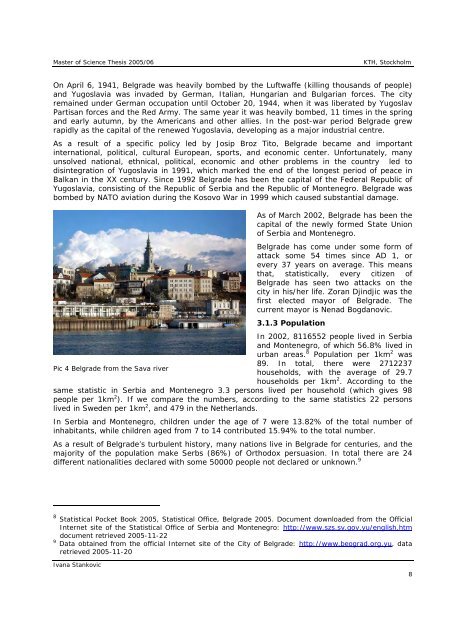Ivana Stankovic
Ivana Stankovic
Ivana Stankovic
Create successful ePaper yourself
Turn your PDF publications into a flip-book with our unique Google optimized e-Paper software.
Master of Science Thesis 2005/06<br />
KTH, Stockholm<br />
On April 6, 1941, Belgrade was heavily bombed by the Luftwaffe (killing thousands of people)<br />
and Yugoslavia was invaded by German, Italian, Hungarian and Bulgarian forces. The city<br />
remained under German occupation until October 20, 1944, when it was liberated by Yugoslav<br />
Partisan forces and the Red Army. The same year it was heavily bombed, 11 times in the spring<br />
and early autumn, by the Americans and other allies. In the post-war period Belgrade grew<br />
rapidly as the capital of the renewed Yugoslavia, developing as a major industrial centre.<br />
As a result of a specific policy led by Josip Broz Tito, Belgrade became and important<br />
international, political, cultural European, sports, and economic center. Unfortunately, many<br />
unsolved national, ethnical, political, economic and other problems in the country led to<br />
disintegration of Yugoslavia in 1991, which marked the end of the longest period of peace in<br />
Balkan in the XX century. Since 1992 Belgrade has been the capital of the Federal Republic of<br />
Yugoslavia, consisting of the Republic of Serbia and the Republic of Montenegro. Belgrade was<br />
bombed by NATO aviation during the Kosovo War in 1999 which caused substantial damage.<br />
As of March 2002, Belgrade has been the<br />
capital of the newly formed State Union<br />
of Serbia and Montenegro.<br />
Belgrade has come under some form of<br />
attack some 54 times since AD 1, or<br />
every 37 years on average. This means<br />
that, statistically, every citizen of<br />
Belgrade has seen two attacks on the<br />
city in his/her life. Zoran Djindjic was the<br />
first elected mayor of Belgrade. The<br />
current mayor is Nenad Bogdanovic.<br />
3.1.3 Population<br />
In 2002, 8116552 people lived in Serbia<br />
and Montenegro, of which 56.8% lived in<br />
urban areas. 8 Population per 1km 2 was<br />
89. In total, there were 2712237<br />
Pic 4 Belgrade from the Sava river<br />
households, with the average of 29.7<br />
households per 1km 2 . According to the<br />
same statistic in Serbia and Montenegro 3.3 persons lived per household (which gives 98<br />
people per 1km 2 ). If we compare the numbers, according to the same statistics 22 persons<br />
lived in Sweden per 1km 2 , and 479 in the Netherlands.<br />
In Serbia and Montenegro, children under the age of 7 were 13.82% of the total number of<br />
inhabitants, while children aged from 7 to 14 contributed 15.94% to the total number.<br />
As a result of Belgrade’s turbulent history, many nations live in Belgrade for centuries, and the<br />
majority of the population make Serbs (86%) of Orthodox persuasion. In total there are 24<br />
different nationalities declared with some 50000 people not declared or unknown. 9<br />
8 Statistical Pocket Book 2005, Statistical Office, Belgrade 2005. Document downloaded from the Official<br />
Internet site of the Statistical Office of Serbia and Montenegro: http://www.szs.sv.gov.yu/english.htm<br />
document retrieved 2005-11-22<br />
9 Data obtained from the official Internet site of the City of Belgrade: http://www.beograd.org.yu, data<br />
retrieved 2005-11-20<br />
<strong>Ivana</strong> <strong>Stankovic</strong><br />
8
















